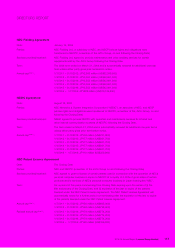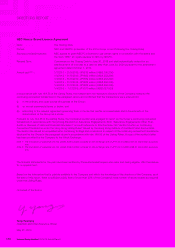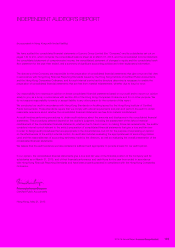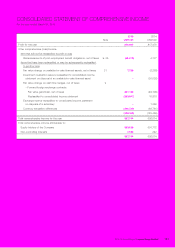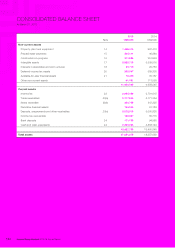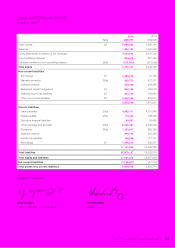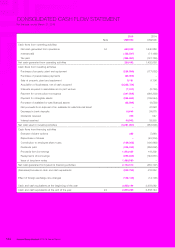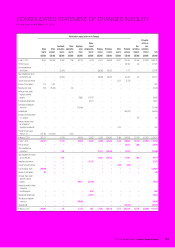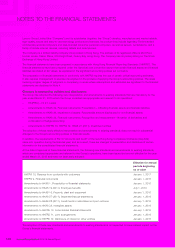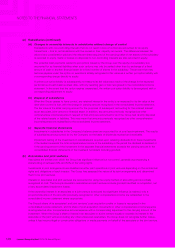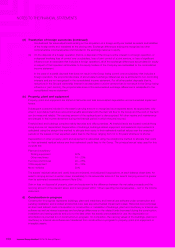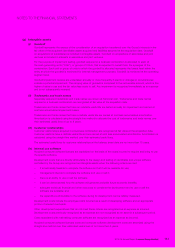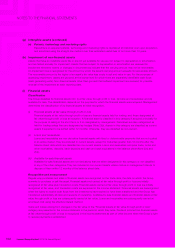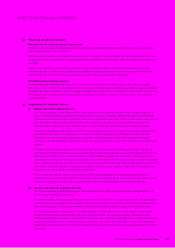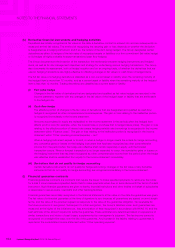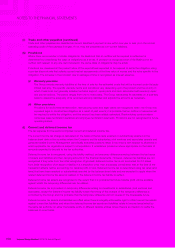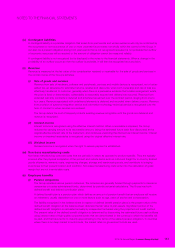Lenovo 2015 Annual Report Download - page 149
Download and view the complete annual report
Please find page 149 of the 2015 Lenovo annual report below. You can navigate through the pages in the report by either clicking on the pages listed below, or by using the keyword search tool below to find specific information within the annual report.
147
2014/15 Annual Report Lenovo Group Limited
NOTES TO THE FINANCIAL STATEMENTS
2 SIGNIFICANT ACCOUNTING POLICIES
The significant accounting policies adopted in the preparation of these financial statements are set out below. These policies
have been consistently applied to all the years presented, unless otherwise stated.
(a) Subsidiaries
(i) Consolidation
The consolidated financial statements include the financial statements of the Company and all of its subsidiaries
made up to March 31.
Subsidiaries are all entities (including structured entities) over which the Group is exposed to, or has rights to,
variable returns from its involvement with the entity and has the ability to affect those returns through its power
over the entity generally accompanying a shareholding of more than one half of the voting rights. The existence
and effect of potential voting rights that are currently exercisable or convertible are considered when assessing
whether the Group controls another entity. The Group also assesses existence of control where it does not have
more than 50% of the voting power but is able to govern the financial and operating policies by virtue of de-facto
control. De-facto control may arise from circumstances where it does not have more than 50% of the voting power
but is able to govern the financial and operating policies by virtue of de-facto control such as enhanced minority
rights or contractual terms between shareholders, etc.
Subsidiaries are fully consolidated from the date on which control is transferred to the Group. They are de-
consolidated from the date that control ceases.
Inter-company transactions, balances, income and expenses on transactions are eliminated. Profits and losses
resulting from inter-company transactions that are recognized in assets are also eliminated.
Adjustments have been made to the financial statements of subsidiaries when necessary to align their accounting
policies to ensure consistency with the policies adopted by the Group.
For subsidiaries which adopted December 31 as their financial year end date for statutory reporting purposes,
their financial statements for the years ended March 31, 2014 and 2015 have been used for the preparation of the
Group’s consolidated financial statements.
(ii) Business combinations
The Group applies the acquisition method to account for business combinations. The consideration transferred
for the acquisition of a subsidiary is the fair values of the assets transferred, the liabilities incurred to the former
owners of the acquiree and the equity interests issued by the Group. The consideration transferred includes the
fair value of any asset or liability resulting from a contingent consideration arrangement. Identifiable assets acquired
and liabilities and contingent liabilities assumed in a business combination are measured initially at their fair values
at the acquisition date. The Group recognizes any non-controlling interest in the acquiree on an acquisition-by-
acquisition basis, either at fair value or at the non-controlling interest’s proportionate share of the recognized
amounts of acquiree’s identifiable net assets.
Acquisition-related costs are expensed as incurred.
If the business combination is achieved in stages, the acquirer’s previously held equity interest in the acquiree
is re-measured to fair value at the acquisition date; any gains or losses arising from such re-measurement are
recognized in profit or loss.
Any contingent consideration to be transferred by the Group is recognized at fair value at the acquisition date.
Subsequent changes to the fair value of the contingent consideration that is deemed to be an asset or liability
is recognized in the consolidated income statement or as a change to other comprehensive income. Contingent
consideration that is classified as equity is not re-measured, and its subsequent settlement is accounted for within
equity.
Goodwill is initially measured as the excess of the aggregate of the consideration transferred, the amount of any
non-controlling interest in the acquiree and, in a business combination achieved in stages the acquisition-date fair
value of any previous equity interest in the acquiree over the net identifiable assets acquired and liabilities assumed
(Note 2(g)(i)). If it is less than the fair value of the net assets of the subsidiary acquired, the difference is recognized
directly in the consolidated income statement.


